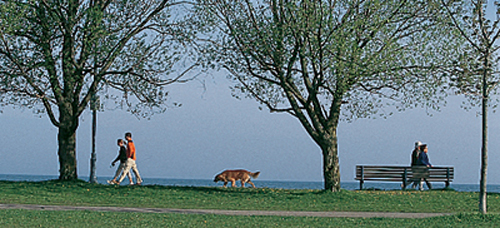|

|
Toronto’s smaller downtown Chinatown is at Broadview Avenue and Gerrard Street, on the city’s east side
|
|
The Beach A
charming enclave east of Woodbine Ave full of fun for the outdoor
enthusiast, including those who consider shopping a sport. Browse the
eclectic shops or relax in one of the many cozy restaurants or pubs . Just south of the Queen Street East strip, a popular boardwalk stretches alongside a sandy beach to Ashbridges Bay.

Boardwalk, The Beach
Chinatown With
the largest ethnic Chinese population of any North American city, it’s
not surprising that Toronto has several Chinatowns, though none other as
old as this one, settled in the early 1900s. Originally farther east on
Dundas Street, the hub is now Spadina Avenue, where scores of shops and
restaurants – including many Vietnamese ones – rub shoulders. The area
is even more frenetic during Chinese New Year celebrations, usually in
February .

Chinatown signs
Cabbagetown Settled
in the 1840s by hardscrabble Irish immigrants who grew cabbages in
their front gardens to help make ends meet, this area east of Sherbourne
St between Wellesley St E and Gerrard St E is today almost completely
gentrified. Picturesque cottages and Victorian rowhouses with their
lovely gardens are rich in vernacular architectural history, rewarding
exploration .

Cabbagetown
Little Italy Most of the 500,000 Italians who call Toronto home now live north of the city, but the pizzerias, and trattorias
that remain on this once predominantly Italian strip of College St west
of Bathurst St ensure it retains its flair. At night, music and patrons
spill out of trendy bars and restaurants . Yorkville Famous
in the 1960s as a hippie hangout and now the city’s most exclusive
retail district, this window-shoppers’ paradise abounds with eye-candy.
Refined art galleries nestle among chic boutiques, bars, and
restaurants. Visiting movie stars can often be spotted here, especially
during film festival time.

Yorkville
The Danforth This
is the social and commercial heart of Greek and Macedonian life in
Toronto. At night, especially between Chester St and Pape Ave, lively
tavernas are crowded with patrons enjoying souvlaki and seafood,
accompanied by retsina or ouzo. In the day, shops are the draw .

Greek shop on The Danforth
The Annex This
upscale neighborhood is home to students, families, and professionals.
Huge trees front the Edwardian houses. Bloor St, a main traffic artery,
is lined with shops between Bathurst Ave and Spadina Ave selling
inexpensive clothing, jewelry, books, and secondhand CDs, and with
eateries that won’t tax your wallet, including many ethnic and
vegetarian spots. On weekends, the streets and bars are filled with
young revelers . Roncesvalles Toronto’s
Polish community lays claim to this west-end neighborhood. Its heart,
Roncesvalles Ave between Howard Park Ave and Queen St W, is lined with
great Polish delis and bakeries (try the jam donuts). Increasingly
gentrifying as the ethnic population ages and moves on and young
professionals move in, the area still has a working-class feel and
Polish is still spoken in shops and on the street. Leslieville One
of the newer areas of Toronto to take shape as a destination, what this
district lacks in architectural richness it makes up for in character.
Along Queen St E between Carlaw Ave and Leslie St, secondhand furniture,
housewares, and vintage stores offer 1960s and 1970s bric-a-brac,
though you might have to compete with the set designers from the nearby
film studios for the object of your desire. Casual cafés are perfect for
weekend brunches and several good restaurants have opened up here. Little India The
festive spirit of the market bazaars of the Indian subcontinent is
alive and well – even during Toronto’s cold winter – on Gerrard St E
between Greenwood Ave and Coxwell Ave. Shops sell colorful saris, street
vendors cook up tantalizing takeaway, and restaurants serve excellent
Indian fare, from vegetarian masala dosa to halwa, a carrot-based sweet.
|